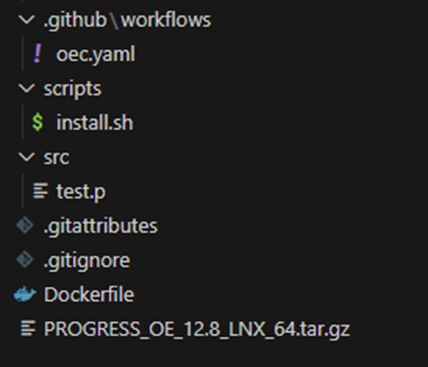Let’s work together
Want to discuss potential opportunities? Pick the most suitable way to contact us.
Book a call+370 5 2 780 400
info@ba.lt
CI/CD is a core practice in software development. However, GitHub Actions lacks native support for Progress OpenEdge. Using Docker, a silent OE installation, and GitHub Actions workflows, we can build and validate OpenEdge applications in a repeatable, containerised environment alongside other modern stacks.
It enables teams to automate builds, run tests, and integrate OpenEdge applications into modern CI/CD pipelines without manual setup. This blog post explains how to implement GitHub actions CI/CD with Progress OpenEdge.
The goal is to enable the build and validation process for Progress OpenEdge applications within a controlled containerised environment in GitHub.
Only use in private repositories.
Because this method requires uploading the OpenEdge installation into the repository, using a private repo is strongly recommended. This ensures that proprietary installation packages are not exposed publicly. The response.ini file is handled securely by storing it in GitHub Secrets.
As in the diagram above, we will use 3 mediums to transfer data from Repository → Actions Runner → Docker container.
We create a GitHub repository with these files:

oec.yaml
File that contains the GitHub Actions workflow. For this use case, the workflow is kept simple. It builds and starts the Docker container with Progress OpenEdge tools.
This workflow has two triggers: on push to the main branch, and on manual_dispatch which can be triggered from the GitHub page.
# Trigger settings — define when this workflow runs:
on:
workflow_dispatch: # Allows manual triggering of the workflow from GitHub UI
push: # Triggers the workflow automatically on code pushed
branches: # Specify which branches this applies to for pushes
- main # Only run when code is pushed to the `main` branch
jobs:
build:
runs-on: ubuntu-latest # Specifies the virtual environment; here, a Ubuntu runner
steps:
- name: Check out repository
uses: actions/checkout@v4 # Uses the official checkout action, version 4 to get the code from repository
with:
lfs: true # If the repo uses Git LFS (Large File Storage), this ensures LFS files are pulled
- name: Add response.ini # Next step to create or populate a file called response.ini
run:
echo "${{ secrets.RESPONSE_INI }}" | base64 --decode > response.ini
- name: Build the Docker image # Step to build a Docker image
run: docker build -t oe-ci .
- name: Run a container from the image # Step to run a container using the built image
run: docker run oe-ci install.sh
In the scripts directory, we have an install.sh script that runs a silent installation and outputs the log file.
This script is optional but prevents the docker build command from terminating without showing errors from the Progress OpenEdge installation process.
/install/openedge/proinst -b /install/openedge/response.ini -l /install/install_oe.log -n
cat /install/install_oe.log Dockerfile
Another crucial file is the Dockerfile, used to install and run Progress OpenEdge inside the GitHub Actions runner. Since GitHub restricts runner modification (available only via the Actions Marketplace), we rely on a Docker container that we can freely modify.
FROM ubuntu:24.04
# We copy openjdk installation and set env variables
ENV JAVA_HOME=/opt/java/openjdk
COPY --from=eclipse-temurin:17.0.15_6-jdk $JAVA_HOME $JAVA_HOME
ENV PATH="${JAVA_HOME}/bin:${PATH}"
# We Add Progress OE installation and the script and then we write to a file
# response.ini content that is kept in a secret.
ADD PROGRESS_OE_12.8_LNX_64.tar.gz /install/openedge/
ADD scripts/install.sh /install/install.sh
COPY response.ini /install/openedge/response.ini
ENV TERM=linux
# Provide permissions for install script.
RUN chmod +x /install/install.sh
RUN /install/install.sh
CMD ["/bin/bash"] Then we have installation files that we will use to setup Progress OpenEdge environment inside GitHub Runner.
PROGRESS_OE.tar.gz
We can use couple of ways to add Progress OpenEdge tools into our GitHub actions environment.
response.ini
This file will be used to silently install Progress OpenEdge inside the Docker container.
So after setting up everything inside the repository, what can we expect?
In the initial approach, we manually uploaded the Progress OpenEdge installer (PROGRESS_OE.tar.gz) and response file (response.ini) into the repository, then used a custom Dockerfile and shell script to perform a silent installation inside the GitHub Actions runner. While this works, it has a few major drawbacks:
A better approach is to create a prebuilt image stored in a private registry (GHCR, Docker Hub, or others), with Progress OpenEdge already installed. This way, the image can be pulled and used to build and run tests without repeating the installation in every CI run.
This blog post walks through setting up a working Progress OpenEdge environment inside GitHub Actions using Docker and silent installation. While it does not yet cover full CI/CD pipelines, it gives you the foundation needed to run builds, tests, and automation for OpenEdge projects in a modern GitHub workflow.
Want to discuss potential opportunities? Pick the most suitable way to contact us.
Book a call+370 5 2 780 400
info@ba.lt
Learn how Progress OpenEdge 12.8 improves data export and import, explained by a Progress Developer at Baltic Amadeus.

Discover how the uneven rollout of the EU’s NIS2 directive in Lithuania, Latvia, and Estonia impacts businesses, and why early compliance is key to avoiding legal, financial, and reputational risks.
Learn how incremental .df files in OpenEdge 12.4 enable safer, phased schema updates with minimal downtime. Ideal for CI/CD and live environments.